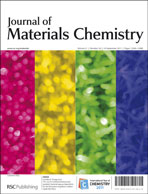In situ fabrication of chalcogenide nanoflake arrays for hybrid solar cells: the case of In2S3/poly(3-hexylthiophene)†
Abstract
A novel strategy for fabricating hybrid thin film solar cell devices based on poly(3-hexylthiophene) (P3HT)/indium sulfide (In2S3) nanoflake array films is presented in this paper. We take In2S3 as an example to demonstrate that a novel chalcalgenide nanoflake array structure could be in situ fabricated on indium-


 Please wait while we load your content...
Please wait while we load your content...